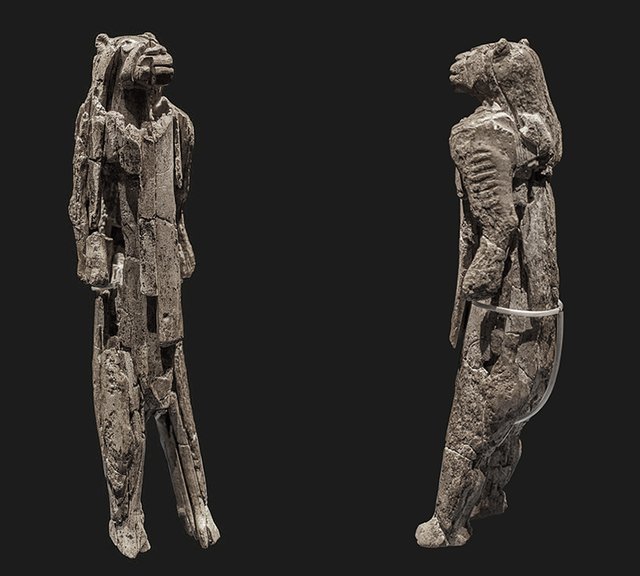The first figurative art known to historians is a forty-thousand year old sculpture of a lion-headed human, often called Löwenmensch or Lion-Man.

Image: wikipedia commons/Thilo Parg
This nearly 12" tall statue was carved from woolly mammoth tusk 40,000 years ago, placing the time of production during the Upper Paleolithic period. It was found in the Haldenstein caves, located in the Swabian Alps of Germany in 1939 (1).

Image from Kronneck, et. al, 2004 (2)
The statue has been interpreted as both male and female by different researchers (3). The sex intended by the artist will probably never be known.
It is also the first uncontested depiction of a composite creature, or “chimera”. According to archaeologist David Wengrow, this early example of composite is utterly out of its place in time: it is one of only a handful of composites in the archeological record prior to the emergence of cities and the popularization of mechanized artistic reproduction (4).
References
1. Dalton, R. (2003). Lion man takes pride of place as oldest statue. Nature,425(6953), 7-7.
2. Konneck, P., Niven, L., & Uerpmann, H. P. (2004). Middle Palaeolithic Subsistence in the Lone Valley (Swabian Alb, Southern Germany). Int. J. Osteoarchaeol, 14, 212-224.
3. Schulz, M. (2011, December 9). Is the Lion Man a Woman? Solving the Mystery of a 35,000-Year-Old Statue. Retrieved August 08, 2016, from http://www.spiegel.de/international/zeitgeist/is-the-lion-man-a-woman-solving-the-mystery-of-a-35-000-year-old-statue-a-802415.html
4. Wengrow, David. 2013. The Origins of Monsters: Image and Cognition in the First Age of Mechanical Reproduction: Princeton University Press.
Cool
Downvoting a post can decrease pending rewards and make it less visible. Common reasons:
Submit